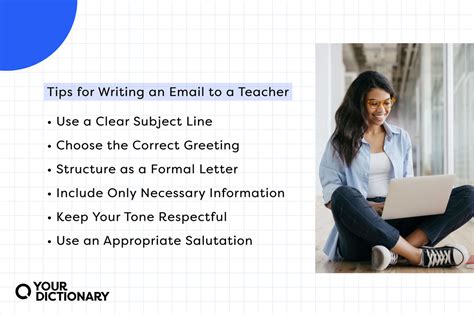Introduction
Effective communication with teachers is crucial for academic success. Emails have become an essential means of communication in the modern educational landscape. Writing a well-crafted email to a teacher can help students clarify doubts, request assistance, and build a positive rapport. This guide will provide a comprehensive overview of how to write an effective email to a teacher, ensuring clarity, professionalism, and respect.

Subject Line: Make it Clear and Concise
The subject line is the first impression you make on the recipient. It should be informative and to the point, providing a brief summary of the email’s purpose. Avoid using vague or overly general subject lines that may result in the email being overlooked.
Tips:
- Keep the subject line under 50 characters.
- Use keywords that accurately describe the email’s content.
- For example: “Request for Clarification on Assignment Due Date”
Greetings: Be Respectful and Professional
Begin the email with a formal greeting that acknowledges the teacher’s position and name. Avoid using informal or slang terms that may be disrespectful.
Tips:
- Use “Dear Professor/Ms./Mr. [Teacher’s Last Name]”
- If you have a close relationship with the teacher, use “Hello [Teacher’s First Name]:”
Introduction: State Your Purpose Clearly
In the introductory paragraph, clearly state the purpose of your email. Be specific and concise, explaining what you need from the teacher. Avoid rambling or beating around the bush.
Tips:
- Start with a clear statement like: “I am writing to request clarification on the assignment due date.”
- Provide any necessary background information or context.
Body: Organize Your Thoughts Logically
The body of the email should be organized logically, presenting your request or inquiry in a clear and coherent manner. Use proper grammar and spelling throughout.
Tips:
- Break down your request into smaller paragraphs.
- Use bullet points or numbered lists to present multiple questions or points.
- Provide specific examples or supporting details to clarify your request.
Closing: Express Appreciation and Sign Off
End the email with a polite closing that expresses appreciation for the teacher’s time and assistance. Include your name and any necessary contact information if the teacher needs to follow up.
Tips:
- Use “Thank you for your time and consideration.”
- If you need a response, include “Please let me know if you have any further questions.”
- Sign off with “Sincerely,” or “Best regards,” followed by your name.
Additional Tips for Emailing Teachers
- Proofread your email carefully for any errors in grammar, spelling, or punctuation.
- Be respectful and use appropriate language.
- Avoid sending emails during inappropriate hours (e.g., late at night or early morning).
- Follow up politely if you do not receive a response within a reasonable time frame.
- Use the email exclusively for academic purposes and avoid discussing personal matters.
- If possible, use a professional email address that reflects your academic affiliation.
Table 1: Email Etiquette for Students
| Etiquette | Description |
|---|---|
| Subject Line | Clear and concise, describing email’s purpose |
| Greetings | Formal and respectful, acknowledging teacher’s name |
| Introduction | Clearly states purpose of email, provides context |
| Body | Organized and logical, using proper grammar and spelling |
| Closing | Expresses appreciation, includes contact information |
| Proofreading | Carefully check for errors in grammar, spelling, and punctuation |
| Language | Respectful and appropriate, avoiding informal terms |
| Timing | Send during appropriate hours, avoid late night or early morning |
| Follow Up | Politely follow up if no response within a reasonable time |
| Academic Use | Use email exclusively for academic purposes |
| Professional Address | Use academic email address if available |
Table 2: Common Reasons for Emailing Teachers
| Reason | Description |
|---|---|
| Request Clarification | Seek additional information on assignments, deadlines, or course material |
| Ask for Assistance | Request help with assignments, understanding concepts, or accessing resources |
| Schedule Appointments | Request to meet with teacher for office hours, tutoring, or discussions |
| Submit Questions | Ask specific questions related to course material or assignments |
| Provide Updates | Inform teacher about absences, assignment completion, or any relevant updates |
Table 3: Benefits of Effective Email Communication with Teachers
| Benefit | Description |
|---|---|
| Clarity | Removes misunderstandings and ensures clear communication |
| Efficiency | Saves time and effort compared to in-person meetings |
| Documentation | Creates a written record of communications for future reference |
| Accessibility | Allows students to reach teachers from anywhere with internet access |
| Reduces Pressure | Eliminates the pressure and anxiety associated with face-to-face conversations |
Table 4: Tips for Writing Effective Email Subject Lines
| Tip | Description |
|---|---|
| Use Keywords | Include keywords that accurately describe email’s purpose, such as “Assignment Deadline Inquiry” |
| Keep it Short | Aim for under 50 characters to ensure readability |
| Be Informative | Provide a brief summary of email’s content, such as “Request for Extension on Paper” |
| Avoid Vague Language | Use specific terms to clearly convey message, such as “Schedule Appointment for Office Hours” |
| Customize | If possible, personalize subject line with teacher’s name or course code, such as “Professor Smith: Assignment Question” |
Conclusion
Writing an effective email to a teacher is a skill that can greatly enhance academic success. By following the principles outlined in this guide, you can ensure that your emails are clear, professional, and respectful. Remember to proofread carefully, be mindful of email etiquette, and use the email exclusively for academic purposes. Effective email communication with teachers fosters a positive learning environment, clarifies misunderstandings, and ultimately contributes to your academic growth.
